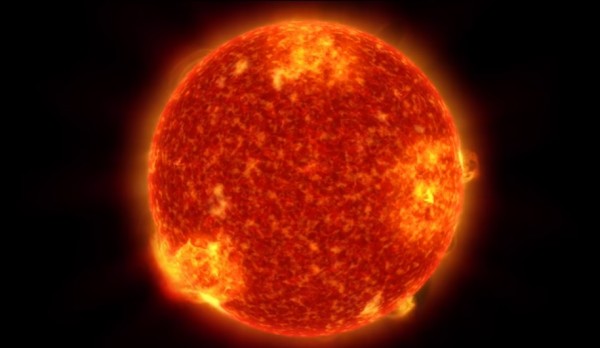Violent Solar Flares Triggered Life on Earth
| Ana Verayo | | May 24, 2016 06:22 AM EDT |
(Photo : NASA's Goddard Space Flight Center/Genna Duberstein) See how energy from our young sun – 4 billion years ago -- aided in creating molecules in Earth's atmosphere that allowed it to warm up enough to incubate life.
Astronomers now believe that powerful solar storms sparked life on Earth some four billion years ago, when the young sun possessed higher energies to trigger life on the planet.
Like Us on Facebook
NASA scientists say that juvenile stars can become extremely violent and the young sun was a prime example of this. Around four billion years ago, the sun's surface was bubbling with powerful eruptions, emitting charged particle clouds of solar material and radiation into deep space.
When these solar storms crashed into the planet known as super flares, they pierced through the planet's protective magnetic field known as the magnetosphere, which has been in a weaker state during that period.
When these active solar particles mixed with the nitrogen in the Earth's atmosphere, this created a greenhouse effect that trapped heat and therefore brewed chemical conditions for life to proliferate.
Scientists believed that almost four billion years ago, the sun's heat was only 70 percent of how it is today, contributing to the "faint young star paradox". This paradox describes how the evidence of liquid water and the weaker solar power that has been shining on Earth that time, was contradictory, as this lesser amount of heat could not have possibly produced the right conditions to create flowing water.
According to lead author of the study, Vladimir Airapetian from NASA's Goddard Space Flight Center, during that time, the planet only received 70 percent of solar energy from the sun compared to today. This would mean that the planet would be covered in ice, instead, geological evidence shows that Earth was filled with warm liquid water, where this is considered as a Faint Young Sun Paradox. Now, this new study shows how solar storms are crucial in warming the infant Earth.
Massive solar storms only occur around once every 100 years or less but data obtained from NASA's Kepler Space Telescope reveals how young stars can produce as many as 10 super flares in a single day. During that time, the sun was considered to be an infant star, where Earth's atmosphere was composed of 90 percent nitrogen, which is 12 percent more than current levels.
In this new study, the active particles that were released by the sun collided into these nitrogen molecules, breaking them down into nitrogen atoms, then colliding with carbon dioxide that produced carbon monoxide and oxygen.
Airapetian explains that these particles that travelled via space weather and slammed into the Earth's magnetosphere, crashed with abundant nitrogen in the atmosphere, that changed the chemistry of the atmosphere completely, which made life entirely possible on Earth.
This new study is published in the journal Nature Geoscience.
Tagssolar storms, solar flares, life on earth, Sun, Earth, evolution of life on Earth, faint young star paradox
©2015 Chinatopix All rights reserved. Do not reproduce without permission
EDITOR'S PICKS
-

Did the Trump administration just announce plans for a trade war with ‘hostile’ China and Russia?
-

US Senate passes Taiwan travel bill slammed by China
-

As Yan Sihong’s family grieves, here are other Chinese students who went missing abroad. Some have never been found
-

Beijing blasts Western critics who ‘smear China’ with the term sharp power
-

China Envoy Seeks to Defuse Tensions With U.S. as a Trade War Brews
-

Singapore's Deputy PM Provides Bitcoin Vote of Confidence Amid China's Blanket Bans
-

China warns investors over risks in overseas virtual currency trading
-

Chinese government most trustworthy: survey
-

Kashima Antlers On Course For Back-To-Back Titles
MOST POPULAR
LATEST NEWS
Zhou Yongkang: China's Former Security Chief Sentenced to Life in Prison

China's former Chief of the Ministry of Public Security, Zhou Yongkang, has been given a life sentence after he was found guilty of abusing his office, bribery and deliberately ... Full Article
TRENDING STORY

China Pork Prices Expected to Stabilize As The Supplies Recover

Elephone P9000 Smartphone is now on Sale on Amazon India

There's a Big Chance Cliffhangers Won't Still Be Resolved When Grey's Anatomy Season 13 Returns

Supreme Court Ruled on Samsung vs Apple Dispute for Patent Infringement

Microsoft Surface Pro 5 Rumors and Release Date: What is the Latest?










